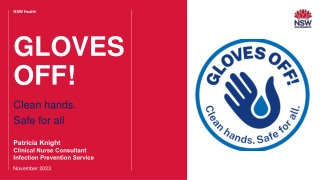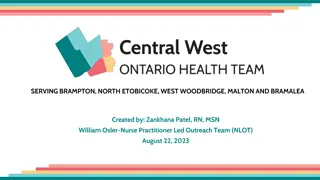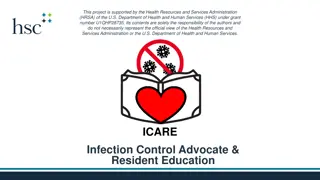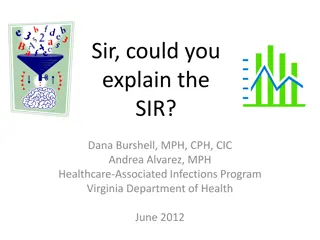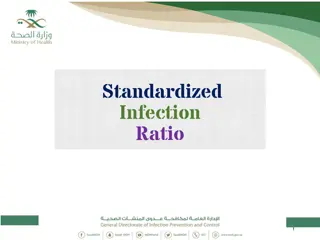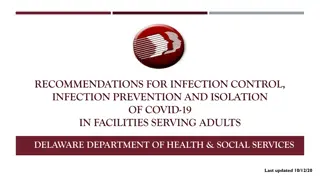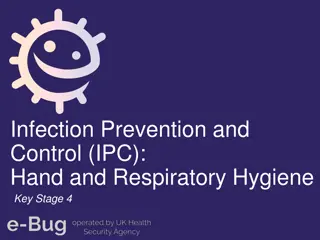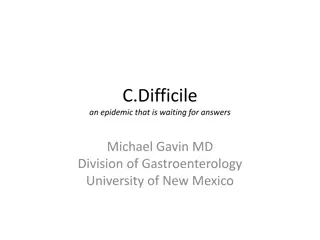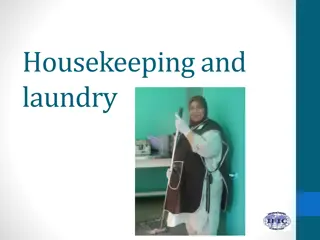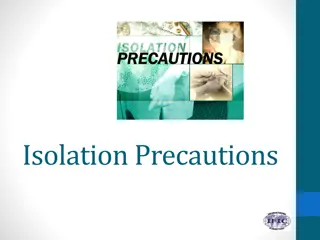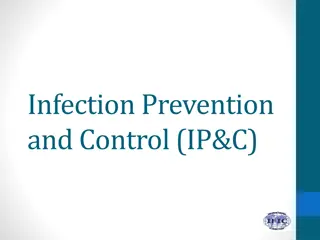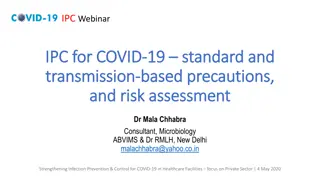Infection Prevention Strategies in Healthcare Settings
Explore the Healthcare-Associated Infections Program focusing on bathing, dressing, implicit bias, and hand hygiene practices for residents. Learn about avoiding germ spread, using personal protective equipment, and promoting diversity and equality in healthcare. Stay informed on key moments for hand hygiene and measures to safeguard residents' health.
Download Presentation

Please find below an Image/Link to download the presentation.
The content on the website is provided AS IS for your information and personal use only. It may not be sold, licensed, or shared on other websites without obtaining consent from the author.If you encounter any issues during the download, it is possible that the publisher has removed the file from their server.
You are allowed to download the files provided on this website for personal or commercial use, subject to the condition that they are used lawfully. All files are the property of their respective owners.
The content on the website is provided AS IS for your information and personal use only. It may not be sold, licensed, or shared on other websites without obtaining consent from the author.
E N D
Presentation Transcript
1 HEALTHCARE-ASSOCIATED INFECTIONS PROGRAM Making a Splash: Bathing and Dressing Residents Project Firstline Healthcare-Associated Infections Program Center for Health Care Quality California Department of Public Health
2 HEALTHCARE-ASSOCIATED INFECTIONS PROGRAM Implicit Bias Describes how our unconscious attitudes or judgements can influence our thoughts, decisions, or actions Includes involuntary, unintentional perceptions made without awareness Occurs as our brains sort information and perceive data to understand our world Affects our decisions, contributing to societal disparities Self awareness about implicit bias can promote healthcare diversity and equality Learn more about your own implicit bias at Project Implicit (implicit.harvard.edu/implicit/)
3 HEALTHCARE-ASSOCIATED INFECTIONS PROGRAM
4 HEALTHCARE-ASSOCIATED INFECTIONS PROGRAM
5 HEALTHCARE-ASSOCIATED INFECTIONS PROGRAM Objectives Describe three ways to avoid spreading germs while providing resident care Review measures to minimize the risk of spreading germs during bathing and dressing residents Identify appropriate personal protective equipment (PPE) to use while bathing and dressing residents
6 HEALTHCARE-ASSOCIATED INFECTIONS PROGRAM Keep All Residents Safe
7 HEALTHCARE-ASSOCIATED INFECTIONS PROGRAM Knowledge Check When is hand hygiene needed? (Select all that apply) A. Before touching a resident B. After body fluid exposure C. After touching resident surroundings D. After touching a resident E. Before clean/aseptic procedures
8 HEALTHCARE-ASSOCIATED INFECTIONS PROGRAM Knowledge Check When is hand hygiene needed? (Select all that apply) A. Before touching a resident B. After body fluid exposure C. After touching resident surroundings D. After touching a resident E. Before clean/aseptic procedures
9 HEALTHCARE-ASSOCIATED INFECTIONS PROGRAM 5 Moments for Hand Hygiene World Hand Hygiene Day, World Health Organization (www.who.int/campaigns/world-hand-hygiene-day)
10 HEALTHCARE-ASSOCIATED INFECTIONS PROGRAM BATHING YOUR RESIDENTS
11 HEALTHCARE-ASSOCIATED INFECTIONS PROGRAM Bathing and Hygiene Hygiene practices keep bodies clean and healthy Bathing is the cleaning of the body for the purposes of relaxation, cleanliness, and healing. Prevents: Yeast or bacterial infections Urinary tract infections (UTI) Device-associated infections Grooming Examples: fingernail care, foot care, hair care
12 HEALTHCARE-ASSOCIATED INFECTIONS PROGRAM Bathing and Hygiene - Continued Types of bathing: showers, baths, bed baths, partial bed baths Never share personal hygiene items (e.g., shampoo, soap, body wash, toothbrushes) Always gather items prior to starting the bath
13 HEALTHCARE-ASSOCIATED INFECTIONS PROGRAM Personal Protective Equipment (PPE) Bathing, showering, dressing, and grooming require: Donning gloves for every task Donning gown when appropriate Donning mask per facility policy
14 HEALTHCARE-ASSOCIATED INFECTIONS PROGRAM Infection Prevention Practices: Bathing Prep Ensure all equipment is clean and disinfected prior to use Bath time is the best time to inspect the skin Perform hand hygiene before donning and after doffing gloves
15 HEALTHCARE-ASSOCIATED INFECTIONS PROGRAM Infection Prevention Practices: Bathing Be gentle Gather all supplies needed before bathing Always wash body from clean areas to dirty areas Change to a new washcloth when the used one gets soiled Ensure all creases/folds in skin are dry to prevent yeast infections Don t forget the feet!
16 HEALTHCARE-ASSOCIATED INFECTIONS PROGRAM Observing the Skin During Bathing Pale, white, reddened, gray, or purple skin Blisters, bruises, or wounds Differences in the temperature of the skin compared to the area around it Complaints of tingling, warmth, or burning Dry, cracked, or flaking skin Itching or scratching Rash or any skin discoloration Swelling Fluid or blood draining Broken skin Changes in existing injury (size, depth, drainage, color, or odor)
17 HEALTHCARE-ASSOCIATED INFECTIONS PROGRAM Peri-Care During Bathing Clean face and upper torso before peri area Work from clean to dirty Change gloves before providing peri care For women: Wash peri area front to back to avoid UTI For men: Clean under the foreskin if uncircumcised; otherwise, it may become infected. Be sure foreskin is gently pulled back in place after cleaning. Gently dry the peri area to prevent lingering moisture which may lead to skin infections (such as yeast)
18 HEALTHCARE-ASSOCIATED INFECTIONS PROGRAM How Can You Apply Infection Prevention Practices During Bathing and Dressing? Gather supplies Enter room Perform hand hygiene Exit room Perform hand hygiene What is something that was missed when re-entering the room?
19 HEALTHCARE-ASSOCIATED INFECTIONS PROGRAM Device Care During Bathing Perform hand hygiene and don gloves before handling any device Keep any wound dressing dry unless otherwise specified Ensure tracheostomy, feeding tubes, or other devices are secured Urinary Catheters Central/Intravenous (IV) Lines Keep central line or IV line dressings dry Notify RN if any dressing becomes wet or smells bad Ensure urinary catheters are secured to resident Keep bag below level of the bladder
20 HEALTHCARE-ASSOCIATED INFECTIONS PROGRAM Knowledge Check To prevent the spread of infection, what must you, as the CNA, do before handling any devices? (Select all that apply) A. Perform hand hygiene B. Use appropriate personal protective equipment (PPE) C. Ask the resident how they are doing D. Wash your gloves
21 HEALTHCARE-ASSOCIATED INFECTIONS PROGRAM Knowledge Check To prevent the spread of infection, what must you, as the CNA, do before handling any devices? (Select all that apply) A. Perform hand hygiene B. Use appropriate personal protective equipment (PPE) C. Ask the resident how they are doing D. Wash your gloves
22 HEALTHCARE-ASSOCIATED INFECTIONS PROGRAM DRESSING YOUR RESIDENTS
23 HEALTHCARE-ASSOCIATED INFECTIONS PROGRAM Dressing Part of daily care for all residents The act of putting on clean clothes
24 HEALTHCARE-ASSOCIATED INFECTIONS PROGRAM Infection Prevention Practices While Dressing Residents Affected/involved side(s) Gather all supplies Hand hygiene Ensure safe environment Tops bottoms footwear Bras at waist then rotated Roll or fold down socks before putting them on
25 HEALTHCARE-ASSOCIATED INFECTIONS PROGRAM Infection Prevention Practices While Dressing Residents - Continued Report any changes in residents' skin Dispose of soiled clothing per facility policy Do not hold soiled items against your body Perform hand hygiene Ensure clothing is changed daily Never mix dirty clothes, linen, or towels with clean items Check residents with incontinence every 2 hours
26 HEALTHCARE-ASSOCIATED INFECTIONS PROGRAM Dressing Residents with IV Lines When dressing: Put clean clothing on the side with the IV first Slide the correct opening over bag, then over the tubing When undressing: Remove clothing from side without the IV first Lift the clothing over the IV site and move clothing over the bag
27 HEALTHCARE-ASSOCIATED INFECTIONS PROGRAM Considerations for Dressing Residents with IV Lines Ensure tubing is not dislodged Check IV dressing is in place Ensure IV is dripping properly Never disconnect IV lines Never turn off IV pump Always keep IV bag higher than the IV site on the body
28 HEALTHCARE-ASSOCIATED INFECTIONS PROGRAM Highlights Infection prevention practices during bathing and dressing help prevent infections in the resident and help keep germs from spreading among residents Select and use appropriate PPE Ensure all equipment is clean and disinfected before and after use Never share personal hygiene products between residents Remember to always wash from clean areas to dirty areas
29 HEALTHCARE-ASSOCIATED INFECTIONS PROGRAM References About Project Firstline | Centers for Disease Control and Prevention (CDC) (www.cdc.gov/infectioncontrol/projectfirstline/about.html) Core Infection Prevention Practices | California Department of Public Health (CDPH) (www.cdph.ca.gov/Programs/CHCQ/HAI/CDPH%20Document%20Library/2019_2_Cor eInfectionPreventionPractices_Approved02.22.19.pdf) Personal Hygiene | CDC (www.cdc.gov/healthywater/hygiene/body/index.html)
30 QUESTIONS AND DISCUSSION
31 HEALTHCARE-ASSOCIATED INFECTIONS PROGRAM Project Firstline Resources Visit the Project Firstline Website (www.cdph.ca.gov/Programs/CHCQ/HAI/Pages/ProjectFirstline.aspx) Subscribe to CNA Today A Newsletter for CNA! (cdph-marketing.powerappsportals.com/HAI/HAI-Registration/) Email the Project Firstline AskBox ProjectFirstline@cdph.ca.gov Project Firstline is a national collaborative led by the U.S. Centers for Disease Control and Prevention (CDC) to provide infection control training and education to frontline healthcare workers and public health personnel. The California Department of Public Health Healthcare-Associated Infections (HAI) Program is proud to partner with Project Firstline, as supported through Strengthening HAI/AR Program Capacity (SHARP) funding. CDC is an agency within the Department of Health and Human Services (HHS). The contents of this presentation do not necessarily represent the policies of CDC or HHS and should not be considered an endorsement by the Federal Government.


